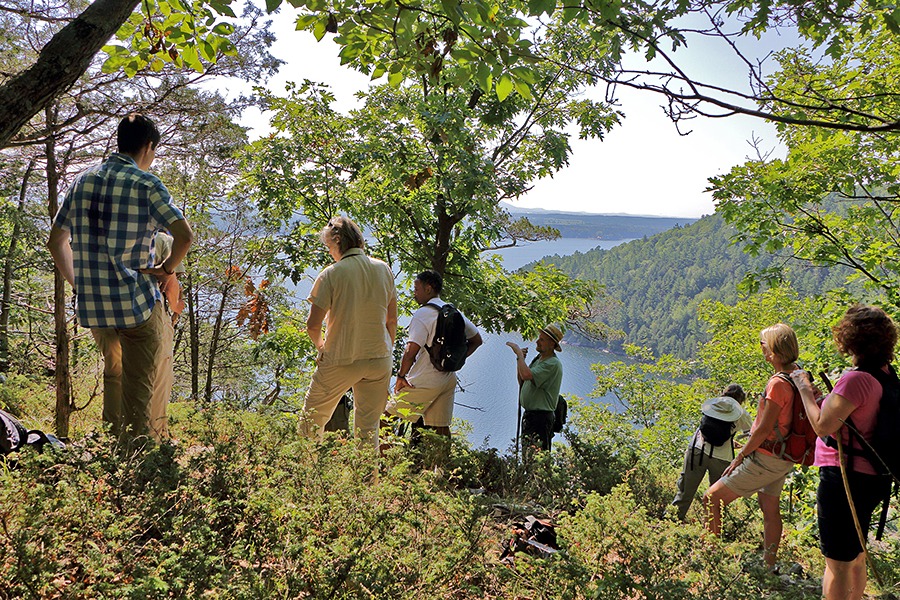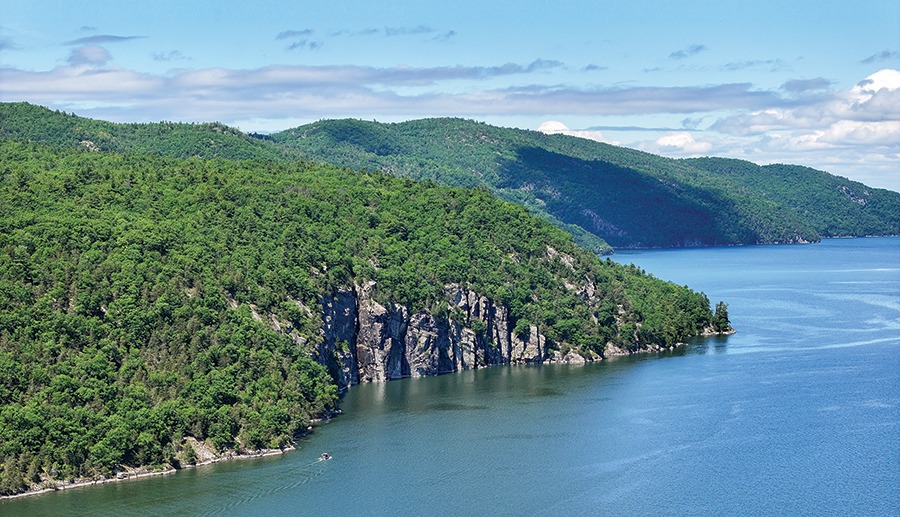
Named after a small, rocky headland jutting into Whallon Bay that is “split” in two, Split Rock Mountain in Essex and Westport, New York has been an important natural and cultural landmark since the area was first inhabited by humans. The Split Rock headland served as the historical dividing line between the Algonquin and Iroquois Indian nations, as well as the boundary between French and English interests at the conclusion of the second French and Indian War in 1713.
Rising over 1,000 feet above Lake Champlain, Split Rock Mountain is a natural and recreational treasure featuring mature forests, rare wildlife habitats, nearly three miles of pristine shoreline, and over eleven miles of scenic hiking trails. Boaters and paddlers cherish the area’s secluded bays, seasonal waterfalls that cascade directly into the Lake, and dramatic, 150-foot high Champlain Palisades. Highly visible from the Towns of Charlotte and Ferrisburgh, as well as the Charlotte to Essex Ferry, the Split Rock Mountain Shoreline is considered by many to be the most scenic area on Lake Champlain.
The Lake Champlain Land Trust is proud to have played a role in protecting this regional hiking and kayaking destination. The story of how this amazing land came to be conserved is a fascinating, but largely unknown, tale of responsible private land stewardship, state government and non-profit conservation group partnerships, and dramatic eleventh hour negotiations. Read on for a timeline of important events in the conservation of Split Rock Mountain.
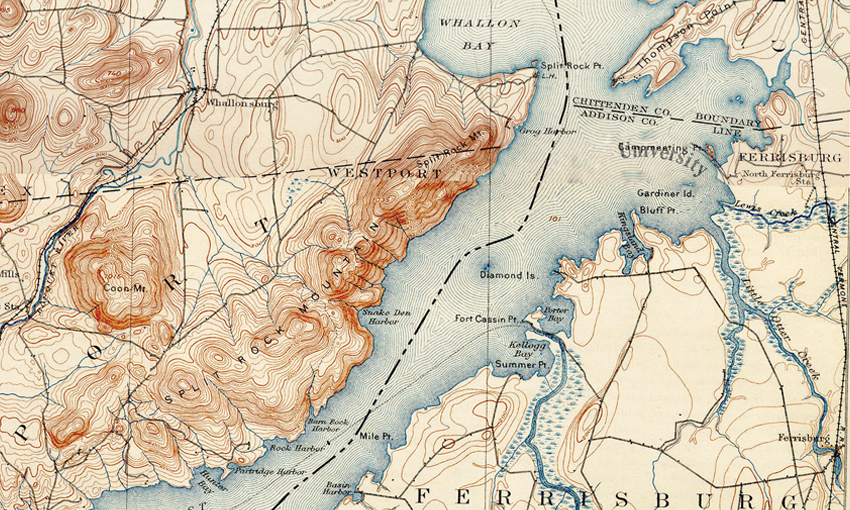

Conservation Timeline:
1898: The State of New York acquires a 200-acre parcel located at the southern end of Split Rock Mountain at a tax sale.
Early 1900s: At a time when large forestland parcels were being clear-cut, Henry Lee Higginson, founder of the Boston Symphony Orchestra, purchases 13 miles of Lake Champlain shoreline along Split Rock Mountain in Essex and Westport, NY. The forestland portion of the property was reportedly never developed because of Mr. Higginson’s respect for its natural beauty. Unfortunately, over time the property was broken up and the southern parcels were sold off without restrictions.
1959: The Heurich family of Washington, D.C. purchases a large part of the original Higginson property and begins 35 years of stewardship.
January 1978: Lake Champlain Land Trust (then the Lake Champlain Islands Trust) is incorporated. Split Rock Mountain is widely known as one of the largest undeveloped shorelands on Lake Champlain.
March 1981: Using funds provided under the 1972 Environmental Quality Bond Act, the State of New York purchases 1,245 acres south and west of the original 200-acre Split Rock Mountain parcel. This acquisition includes nearly two-and-a-half miles of undeveloped Lake Champlain shoreline.
Summer 1988 to Summer 1989: Local press reports detail ongoing negotiations between Split Rock landowner Gary Heurich and New York State Department of Environmental Conservation officials regarding the possible sale of his family property to the State. Mr. Heurich publicly states his support for permanent protection of the land through state ownership and agrees to a tentative deal contingent on the State being able to fund the purchase using monies from a planned $1.9 billion Environmental Bond Act.
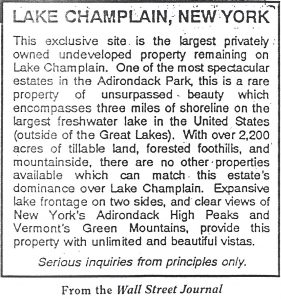
November 1990: New York State voters unexpectedly defeat the Environmental Bond Act at the ballot box, resulting in the collapse of the Heurich deal.
January 1991: The Heurich property is listed for sale and advertised in newspapers, including the Wall Street Journal.
Spring 1991 and 1992: Environmental trust fund legislation aimed at providing acquisition funds for priority projects such as Heurich’s Split Rock Mountain property is passed by the New York State Assembly, but is blocked in the New York State Senate.
Fall 1992: A coalition on conservation partners, including the Lake Champlain Land Trust, the Nature Conservancy, and the Open Space Institute, forms with the ambitious goal of securing a deal to purchase the Heurich forestland. Months of negotiation and a major fundraising campaign ensue.
Winter and Spring 1993: The Lake Champlain Land Trust and partners work tirelessly to secure over $1.5 million dollars in funding commitments from members, foundations and private donors across the Champlain Basin. The conservation partners work with the landowner to negotiate a deal that relies on the State of New York securing the necessary funds to purchase the property.
Spring 1993: With state land acquisition funding in question as the Environmental Trust Fund legislation remains pending in the State Legislature, the Heurich property is set to be auctioned off to the highest bidder on May 25, 1993. Advertisements are placed and an auction binder is circulated to real estate agents.
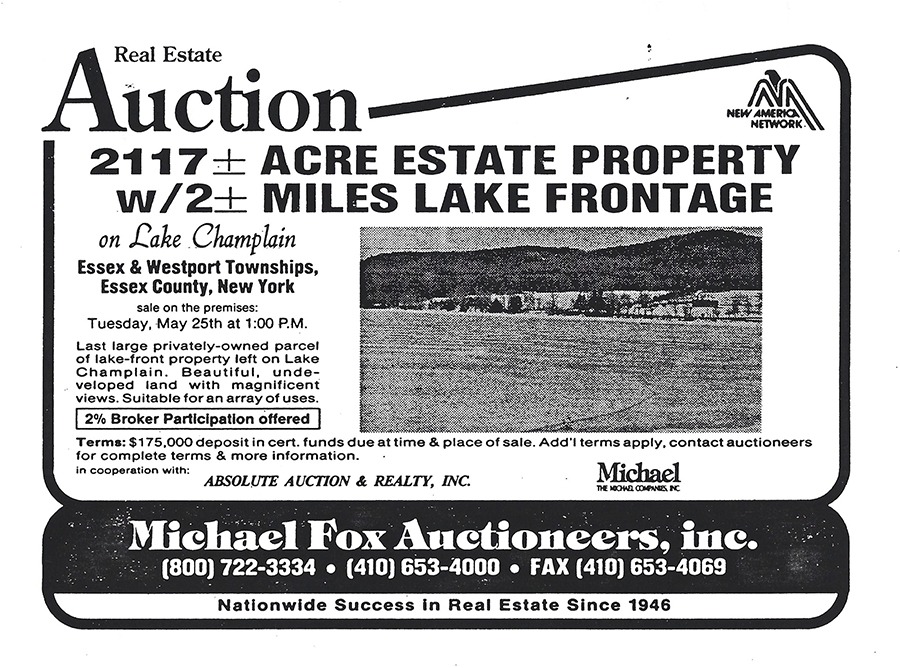
May 25, 1993: Potential buyers gather at the Heurich Estate for the auction. While developers and bidders wait under the auction tent, the conservation partners reach an agreement with the landowner as he was driving to the auction site! The deal gives the partners the option to purchase the property through the end of the current New York State Legislative Session. The option depends on the State of New York securing over $2 million via a proposed Environmental Trust Fund to be used to purchase the property.
July 9, 1993: On the very last day of the Legislative Session, the New York State Assembly and Senate, and Governor Mario Cuomo agree on a compromise version of the Environmental Trust Fund legislation. The bill is passed during a marathon all-night session and sent to Governor Mario Cuomo for his signature.
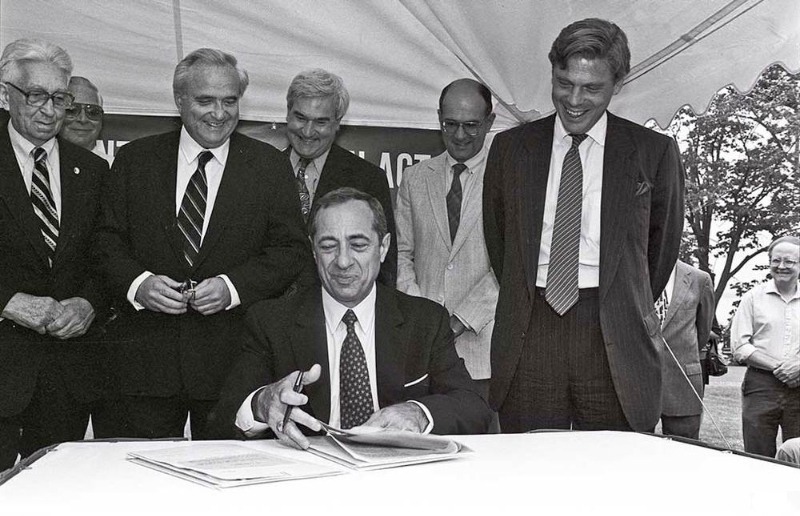
August 17, 1993: Governor Cuomo signs the Environmental Trust Fund legislation at a bill signing ceremony at the Split Rock property.
November 18, 1993: The Open Space Institute (OSI) closes on the purchase of the 1,829-acre Split Rock Mountain forestland and Webb Royce Swamp tracts, as well as an option on a conservation easement protecting nearly 400 acres of woodlands and fields surrounding the Heurich family’s Split Rock Farm.
December 9, 1994: OSI transfers the Split Rock Mountain forestland and Webb Royce Swamp tracts to the State of New York for inclusion in the “forever wild” Adirondack Forest Preserve.
1999: The NYS Department of Environmental Conservation creates a new 3,700-acre Split Rock Mountain Wild Forest Unit of the Adirondack Park Forest Preserve. The Management Unit contains Split Rock Mountain, Webb Royce Swamp, and the Heurich Conservation Easement lands.
Today: The Split Rock Mountain Wild Forest is now the largest protected area on the New York side of Lake Champlain. With the majority of the forest undisturbed by logging, farming and settlement for over 100 years thanks to the vision and careful stewardship of the Higginson and Heurich families, Split Rock is home to mature and healthy forests. The protected area provides critical habitat for Bald Eagles and the rare Timber Rattlesnake, as well as safe passage for wide-ranging mammals crossing between New York’s Adirondack and Vermont’s Green Mountains. Split Rock offer hikers and paddlers a remote wilderness experience in the heart of the Champlain Valley.
The Lake Champlain Land Trust remains committed to protecting the ecological treasures of Split Rock Mountain Wild Forest, and is working with nearby landowners to conserve additional lands to expand and buffer this irreplaceable lakeshore forest block and wildlife corridor.
